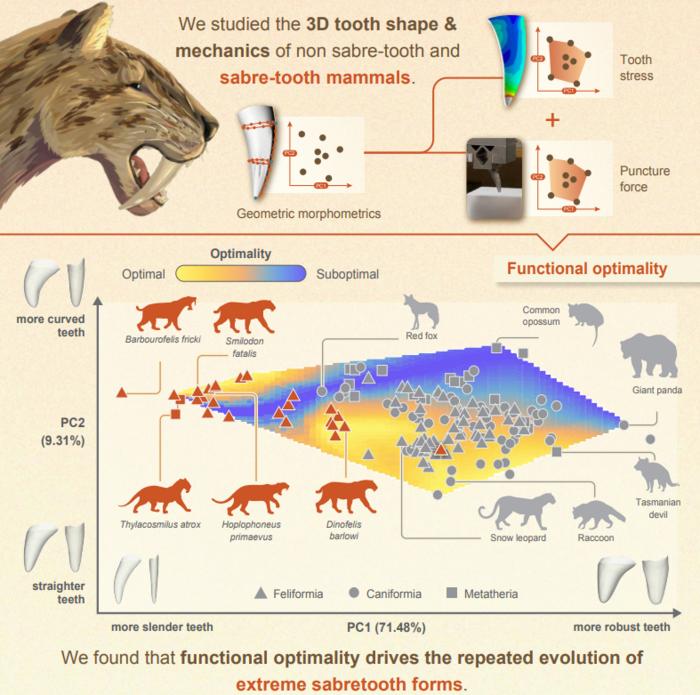The Fascinating Evolution of Sabre-Toothed Predators: A New Study Unveils the Functional Optimality Driving Their Repeated Appearance
In a groundbreaking study published in the esteemed journal Current Biology, researchers have provided new insights into the evolutionary history of sabre-toothed predators, most notably represented by the iconic Smilodon. This research sheds light on the underlying mechanisms that facilitated the independent evolution of sabre-toothed traits across different lineages of mammals. By connecting evolutionary theory with biomechanics, the study reveals how specific adaptations, such as elongated, sharp teeth, offered these predators significant advantages in capturing prey.
This study, led by a team of scientists from the University of Bristol and Monash University, analyzes the structural complexities and biomechanical performances of sabre-toothed teeth. Their research demonstrates that these teeth were not only efficient tools for hunting but also stood as prime examples of evolutionary innovation. The discovery of these functional adaptations helps explain why sabre-toothed morphology evolved at least five separate times across various mammalian lineages, presenting a compelling narrative about convergent evolution in response to similar ecological demands.
At the core of this research lies the concept of functional optimality. By examining the interplay between morphological features and hunting abilities, the scientists aimed to identify how these evolutionary adaptations represent an optimal solution to the challenges faced by predatory mammals. Their findings suggest that the sabre-toothed design—characterized by its long, blade-like teeth—strikes a delicate balance between sharpness necessary for effective puncturing and robustness for durability during hunting.
The research methodology employed by the team involved pioneering experiments using 3D-printed steel tooth replicas, which allowed for precise testing under controlled biting conditions. This innovative approach enabled researchers to simulate various predatory scenarios to determine how different tooth shapes reacted to mechanical stress. In total, they evaluated the tooth structures of 95 carnivorous mammal species, including 25 that displayed the distinctive sabre-tooth morphology.
Interestingly, lead author Dr. Tahlia Pollock remarked on the implications of these findings for our understanding of extreme evolutionary adaptations. The study not only expands our knowledge of sabre-toothed predators but also enhances our comprehension of evolutionary principles that govern the adaptation of diverse species in response to ecological pressures. By integrating biomechanics and evolutionary strategy, the researchers uncovered vital clues regarding how natural selection propels the development of specialized traits across various taxa.
Moreover, the study challenges the long-standing classification of sabre-toothed predators into two dominant categories: ‘dirk-toothed’ and ‘scimitar-toothed.’ Instead, the research presents a nuanced perspective that depicts a continuum of tooth shapes, revealing greater variability among these predators than previously recognized. For example, while Barbourofelis fricki displayed long, curved teeth suited for specific hunting tactics, the straighter and sturdier teeth of Dinofelis barlowi indicate that these adaptations provided distinct hunting advantages tailored to varied prey and environmental conditions.
The researchers propose that this diversity is not merely a result of chance but reflects a series of evolutionary experiments, adapting to the fluctuating conditions of prehistoric ecosystems. With ecosystems undergoing constant changes, the specialization of sabre-toothed predators may have contributed to their efficiency as hunters; however, it could have also established a precarious scenario for their sustainability, ultimately making them susceptible to extinction during periods of ecological turmoil.
Looking forward, the research team intends to broaden the scope of their analysis beyond sabre-tooth morphology to include a comprehensive examination of all carnivorous dental structures. This expanded research aims to elucidate the biomechanical trade-offs inherent in diverse tooth shapes found throughout the animal kingdom, facilitating a deeper understanding of evolutionary dynamics.
In addition to its immediate implications for the study of sabre-toothed predators, these findings hold broader significance for the fields of evolutionary biology and biomechanics overall. Insights garnered from the biomechanics of sabre-toothed teeth can be invaluable, even extending to bioinspired engineering applications, where understanding nature’s designs can inspire innovative solutions for contemporary challenges. Thus, this study not only delves into the mystery of an iconic predator but also contributes to a larger narrative in our understanding of adaptive evolution across the spectrum of life.
Furthermore, the findings of this research carry substantial implications for how scientists might predict future evolutionary trajectories in the face of environmental shifts. By examining the evolutionary pressures that shaped these remarkable specialists, researchers can better forecast how current species might adapt—or fail to adapt—to the challenges posed by rapidly changing ecosystems due to climate change and habitat destruction.
In conclusion, the study captures the intricate links between evolutionary adaptations, ecological pressures, and the specific physiological traits that enhance survival. As we continue to unravel the complexities of evolutionary history, research such as this serves to deepen our appreciation of nature’s ingenuity, demonstrating how innovation through adaptation shapes the dazzling variety of life we see today.
Through this investigation of sabre-tooted adaptations, researchers provide an essential stepping stone toward bridging gaps in our understanding of how anatomy and function interact through time. It showcases the potential for future interdisciplinary studies that enhance our grasp of the mechanics of evolution, and the lessons learned may inspire future generations of scientists to push boundaries in exploring life’s remarkable diversity.
Subject of Research:: Animals
Article Title:: Functional optimality underpins the repeated evolution of the extreme ‘sabre-tooth’ morphology
News Publication Date:: 9-Jan-2025
Web References:: University of Bristol, Monash University
References:: ‘Functional optimality underpins the repeated evolution of the extreme ‘sabre-tooth’ morphology’ by Tahlia Pollock et al in Current Biology
Image Credits:: Credit: Tahlia Pollock
Keywords:: Adaptive evolution, Computational simulation/modeling, Evolutionary biology





